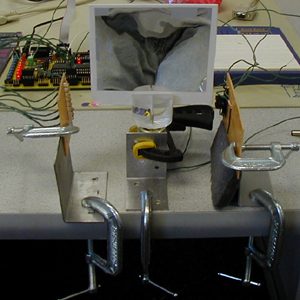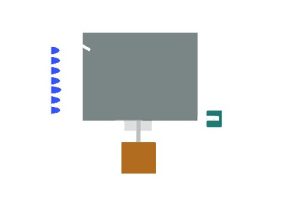Introduction
For our final project, we decided to build a digital message machine which displayed on a mirror. This is a variation from other digital message machines we had seen in stores and in past final projects. Instead of quickly moving a wand of LED’s to display the message on, we decided that holding the LED’s stationary while spinning a mirrored surface close by as a display would be interesting and challenging.
High Level Design
From the beginning we knew the hardest part of this project would be setting up all of the necessary hardware. We planned on using a regular DC motor to spin the mirror surface and using an optical interrupter to time the flashings of the LED’s. Since we were using an optical interrupter, we didn’t feel it was necessary to use a stepper motor for precise turning. Also finding a stepper motor which would turn fast enough and have enough torque for our purposes would have been difficult. We planned on writing code that would dynamically time the period and adjust the timings for the LED’s so that a precise spin speed was not necessary. However, we did need the motor spinning fast enough so that a message would actually be displayed.
Hardware Design
The hardest hardware component to make by far was the motor and mirror mount setup. At first, based on spec. sheet ratings, we assumed that most DC motors would spin too fast for our purposes, but what we didn’t think about was the HUGE amounts of drag that our flat mirrored surface would create. So after many failed attempts, we finally settled on a 9-18VDC motor from Radio Shack rated at 18,000RPM. The only problem with this motor was the large current it drew. Fortunately we were able to find a high current power supply. After finding an appropriate motor, we needed to make a mount upon which we could attach our mirror surface. We ended up machining a clear piece of plastic and attaching it to the motor using high-strength epoxy. Next we needed to find an appropriate reflective surface to spin. We decided to use cardboard and reflective paper to make the entire surface light and easy to spin. The major difficulty with the mirror surface was balancing it correctly on the motor/motor mount. If the surface was not balanced very well the entire motor would shake too much. Also the surface was spinning fast enough that the cardboard was bending slightly which deformed the viewing surface.
For more detail: Digital Mirror Message Machine


